i begin writing this from my new hotel room a few blocks away from the old one. i’m saving $10 by staying here tonight. i may be here tomorrow night, as well. If that is the case… i’ll save $20 on the deal.
It seems like hauling all of my gear across town was a lot of work to go to a vastly inferior hotel room with a public bathroom… but as i told my brother… $15 is three days’ worth of budget for me these days, so Abraham Lincoln may well cry because of how tightly i pinch pennies…
But the paro is over.
For three days the city was down… lots of time with little to do but think and write… and walk around town trying to find a shop into which i could sneak for some ice cream. It’s a Lamborgini Casino ice cream sandwich (chocolate chip ice cream… satisfactory for the purpose for which it is claimed) for breakfast these days with a Sublime (chocolate ice cream, covered in chocolate with a few nuts in the outer chocolate) for afternoon snack.
And of course there’s other food, too… but ice cream is just kind of a really big deal, you know?
But dinner is different. i actually get real food for dinner, you may be surprised to hear.
i do not know why it is… but there is a very large Chinese population in Peru. i haven’t observed such a thriving Chinese population in any of the other Latin American countries in which i have spent time. As a result, there is a fairly large concentration of restaurants called chifas. Chifas aren’t usually Chinese restaurants like we normally think of them. Most chifas have a limited menu that includes some fried rice dishes, some noodle dishes, and maybe a few other simple items… but i have found myself fairly addicted to them.
Will this post be inflammatory? i imagine it probably could be if it is not read gracefully. So if you’re looking for a reason to say angry and negative things about me… well… if you don’t already have a reason, you’re not very good at looking… and so i’ll do you a favor by warning you that if you really want such a reason, you can probably read this post and call me an arrogant racist. Which would probably make me laugh more than it would offend me, because i think that to do so would completely miss what i am saying… but if you want to do so, i suppose that that is your prerogative.
Because i have really come to feel that Latin American culture is generally tremendously racist. i feel like i need to be careful in drawing out comparisons with American culture lest i seem to suggest that i think American culture is ideal… or even any better at all… but i think that people who have followed this blog or who know me very well know that i have some reasonably choice words for American culture, also. So if i could ask anything of my reader, it would be to read this post—really to read anything that i ever write—within the context of everything else that you have divined about me from things that i have said in the past, from where i spend my time and my money, from what you have seen to be desires, and what you have come to see as my character—or lack thereof.
And so rather than reading my statement that Latin American culture is generally tremendously racist as bigoted, self-righteous condemnation, i ask that you instead read it as an effort at an objective statement from a man of unclean lips from a people of unclean lips.
All of which is to say… chifas tend to be kind of on the outside of culture here in Peru. They tend to have successful enough businesses… but i have found that often the owners seem very withdrawn, are seldom interacted with by the clientele—as opposed to the tremendous socializing common with Peruvian owners of Peruvian restaurants—and seem to be on the outside looking in at Peruvian culture very often.
And as i said earlier… i have found myself to be fairly addicted to chifas. When i get into a new town… i look for four things. Most people would look for something like… a place to buy water, a good hotel, maybe a restaurant, and a hospital… or a set of things like that.
i look for a place to buy ice cream, an internet café, a chifa, and a backup ice cream supply. From there, i keep track of any and all additional ice cream supply places. Huamachuco has been hard since everything has been closed… but i know of three stores that sell ice cream, i have seen another store that hasn’t been open since i got here, but that i’m optimistic may carry the stuff, and i have a part of town that i think may offer another store or two.
But if chifas are going to be on the level of ice cream and internet cafés… they must be a pretty big deal.
And there are a few reasons for this… the food is generally pretty good—if you like fried rice—it’s generally very inexpensive—a property of being a little bit outside of the local culture, i think—and… i think i just feel a comfort level at places that are, while fairly integrated into the culture, still very much on the outside looking in.
The paro shut down the whole city of Huamachuco.
My chifa (Chifa Nueva China) never closed.
i ate dinner there on Tuesday night. And on Wednesday. And on Thursday. And i ate lunch there on Friday. And i’m about to eat dinner there tonight… tonight being Friday.
The proprietor is a Chinese man. He stands at the front of the restaurant. He wears a wool beanie with a symbol resembling a Nike swoosh with two hooks stacked on top of each other instead of just one hook.
As i paid on Thursday night, he tried to make some small talk with me. He doesn’t speak very good Spanish. But yes… i’m traveling alone, although a group of friends will be here in the next day or two. Yes… i enjoy Huamachuco. i’ll see you tomorrow, friend.
i walked in this afternoon for lunch, and his normally stern face broke open into a warm smile. He shook my hand, and i asked him what his name is.
“What?”
“What is your name?”
After some back and forth, he understood my question. He pointed to his chest. “Poso!”
His smile came back… bigger than ever, and his hand shot out again.
We were just two outsiders settling in for another afternoon in the rioting town of Huamachuco.
And as a further note on the paro…
The grand finale was this afternoon. The strikers all assembled in the plaza de armas—about two blocks from my hotel—and had… what kind of looked to me a little bit like a high school pep rally.
According to fallingrain.com—an amazing source of information, it is an exhaustive database of all known cities in the world, including coordinates, elevations, and populations—Huamachuco has a population of 7,000. i would estimate that between 2,500 and 3,000 people were gathered at the plaza today.
A platform was set up and fiery speakers spewed passion and vitriol into microphones.
Again… perhaps i condemn myself by commenting on such things as this, as i have never had a hard day in my pampered American life… but it never ceases to amaze me how easy it is to stir a mass of people into a frenzy. And certainly… this wasn’t exactly the most frenzied frenzy of which i have ever heard. There was no violence or anything…
But it seems to me that if you have a crowd of people who think that they are poor… all you have to do to win their hearts is first tell them that they are in fact poor, and then criticize the status quo as much as possible in every way. Alternatives, solutions, defense for criticism of the status quo… these things are all optional.
And talk about fighting. The crowds love when you talk about fighting.
One of the chants that i heard today said:
“Only if the people fight will the government listen to them!”
It works a lot better in Spanish… i promise.
The president of Peru is a man named Alan Garcia. No president of any country is ever popular after he or she has been in office for nine months or a year. Garcia is around year two of this stint as president.
He ran against a man named Moises Ollanta Humala.
i do not profess to be an expert on Peruvian politics… so some of you may even know more about the dynamics of the 2006 election than i do… but allow me to give my impressions, which may be as ignorant as the rest of the things that i say.
From what i gathered, Ollanta made Hugo Chavez look like a US-loving capitalist. He had no extensive education or experience in political matters. He was very militant. He was indigenous. And because he was indigenous and militant, he won the heart of the campesino populations of Peru. Probably most of the places in which i have spent time in voted overwhelmingly for Ollanta.
Peru is a very fragmented society. i haven’t looked at the actual numbers in quite some time… so i may be a little bit off… but about 22 million people or so live in Peru. Of those, over 10 million, i believe, live in or immediately around Lima, the capital city. Over a million live in Arequipa, and the cities of Trujillo and Cusco have populations numbering in the hundreds of thousands. The urban population of Peru is really quite urban… over half of the population lives in two cities. The rural population of Peru is really quite rural… endless villages have no road to them, economies—while certainly increasingly globalized… think MP3 players and DVD players 15 miles from the nearest road—are largely fundamentally still based upon subsistence agriculture and are locally self-sufficient. There is a huge gap between the city people and the country people… and so when there is an election, you can imagine that people who live within 20 miles of the capital city will win, and people who live farther than 20 miles of the capital city will be very angry.
Huamachuco was, i’m sure, overwhelmingly in support of Ollanta. And during politically charged events like this, people don’t tend to forget that they supported Ollanta.
So the fact that they are unhappy and the fact that Alan is president (i don’t know why everybody refers to him by his first name…) become connected in their minds, and the demonstration takes on a decidedly anti-Alan bent.
One chant that i heard for a while translates to something like this:
“Hey Alan, listen! The people find you to be repugnant!”
i was very impressed at their vocabulary that they were using the word repugnant. It was really in a different tense… something like, “The people repugn you!”… but… maybe i’m wrong, but i don’t think that repugn is a verb in English—although i may start using it as one—hence my more licentious translation.
But… again… it just makes me wonder what the people want.
First off… again… i’m no expert of Peruvian politics… but i’m pretty sure Alan (this term) has been one of the best presidents Peru has had in a while. Even if he had to return to Peru from exile to run. (Yes… the election came down to a runoff between the militant, socialist, uneducated Ollanta and the disgraced, exiled Alan Garcia…)
The last president was a man named Toledo. Upon being elected, he went to Machu Picchu and sacrificed a llama to the sun god, i hear. Oh yes… i feel competence coming on. In 2002 i watched him give a speech. He was wearing his pajamas. His hair was disheveled. A Peruvian standing next to me said “That is our president. He embarrasses us”. Toledo was not a success story.
The election that put Toledo in office was between Alan and Toledo. It was forced on the spur of the moment. The previous president was a man named Alberto Fujimori. He had just started his third term, and was generally popular. He had spent his first two terms turning around Peru’s economy after its catastrophic crash at the hands of the previous president. But on a diplomatic trip to Japan—where much of his extended family is—he faxed his resignation back to Peru. There had been a large amount of scandal—Nixon-esque, it seems to me at times—around him for a few months, and he decided to get out while he could. Fujimori wasn’t exactly a model president.
The president before him was Alan Garcia. Our friend! Basically… the entire Peruvian economy crashed and burned and he was exiled. That presidency wasn’t much of a success either…
But from what i have gathered… the economy has been improving under Alan this term. Peru recently established an equivalent of the EPA. Peru recently hosted a meeting of the heads of state of a number of Spanish-speaking countries. Alan really hasn’t been doing too badly… to my knowledge.
But Ollanta was their man, because he was indigenous himself and because he used the fighting rhetoric that the poor so love to hear.
However… i listen to people talking here… or to people red-facedly screaming into a microphone… and they talk about wanting to be like America, to have freedom… but i tell you that most assuredly that is not what they really think that they want.
i spent my previous post discussing briefly why i feel that that is not what they want. But i now say that that is not what they even think that they want. They think that they think that they want it… but it’s not what they want.
It is so easy to understand to rise of totalitarian socialist/communist/fascist dictators. Rhetoric without reason.
Again… i feel reluctant to say what i feel on some aspects of this issue… because i do not intend to say that Peruvians are lazy. i know that probably somewhere between 99-100% of the people that were gathered in that plaza are harder workers than me. But my failures do not diminish the natural human tendency to want to get something for nothing. They only serve as evidence of it.
They demand that the government “catch them up” with people from America or even from the city. They fancy that people in America each have small farms and trek from chacra to chacra every day harvesting their potatoes and corn and quinoa just like people do here. And what i’m saying isn’t intended to belittle their way of life—to the contrary… those who know find that i admire it greatly—but instead to point out that they are trying to live in the protection of the good aspects of another completely different economic structure without changing their way of life at all… and the American economic structure simply does not seem to admit the small farming way of life. We’re an economy of cash and capital with a poverty of time, relationships, and independence. They’re an economy of time, relationships, and independence with a poverty of cash and capital. Who’s poor? Nobody is! We all are!
But… the easiest way to win the heart of a people is to try to offer them both. And so politician after politician taking up populist causes promises to take that money from those nasty, lazy rich people and redistribute it to you poor farmers so that you can have cars and computers and TVs and Nike shoes and digital cameras like they do… and so that is what people expect from the government, i think. That the government will leave those aspects of their life that they like—the independence, the time, the relationships, for example—untouched while subsidizing their cravings for more industrialized goods… which i argued in my previous post will never satisfy them no matter how much they think they want them.
And again… my goal is not to criticize the way of life of the campesinos here… it just bothers me to hear the phrase “extrema pobreza” used so many times.
Extreme poverty.
Oh… and it’s so easy to be arrogant here. And it’s so easy to stand on my velvet pedestal of American citizenship, having never lived a hard day of my life, and romanticize what probably is a very hard life.
But i think that if some of these people were to travel a little bit more… if they were to travel to their very own capital city of Lima and look at the endless shanty towns on the outskirts of the city… they would get a better feel for what extrema pobreza really is. i have seen some extrema pobreza… and i have friends who have worked in extrema pobreza… and i don’t see it here. i was told that Choco was a place of extrema pobreza. i simply don’t believe it.
The people here have meaningful work. They have food. They have shelter. They have independence. They have time. They have friends. They have recreation. They don’t have much cash… but their economy really has no use for cash. They personally have plenty of use for cash, yes, i’m sure. But their economy, the entire social structure on a macro-level… doesn’t really have use for cash. It is funny to me… i think subsistence farming economies might be the purest form of socialism that this world has seen… and that may be a vastly ignorant assessment from an outsider… but there is local independence, there is minimal social stratification, exchanges of goods take place on a personal relationship level much more than on a distant business level… and everywhere in the world that has this pure socialistic order seems to clamor for a large-scale, militant, inevitably corrupt, abusive socialism.
From this velvet pedestal it is easy to romanticize their way of life… but i think that it is much more beautiful than they realize. And i think that this velvet pedestal comes with some pretty big shackles of its own.
Whew… i hate economy and politics. i’ll finally stop pouring forth my ignorance like a fire hydrant in a high school parking lot… and move on to my first photo essay from Choco.
My first picture has very little to do with anything else that i’m going to talk about… but i feel like it would be criminal to forego its inclusion. And if i did something criminal… then i would be qualified to run for political office in a Latin American country (ouch… i know… that was low… i’m feeling just a little bit cynical these days. On the upside… whenever i feel bad about the election in the US this year [which happens to be every time i think about it, actually], i just think about Latin American politics, and suddenly i feel so much better.).
But… When i got to Choco on Monday, June 23, the town was preparing for its annual party—a five day affair beginning on Tuesday, June 24 involving lots of drinking, some pseudo-dancing, lots more drinking, a seemingly quite inebriated marching band, and culminating in a bullfight on Saturday, June 28.
So on Tuesday morning i hiked a short distance upstream to spend some time reading and studying. And what? Las Llamas de Choco! AAAAAHHHHHHH!!!! THIS IS SO EXCITING!
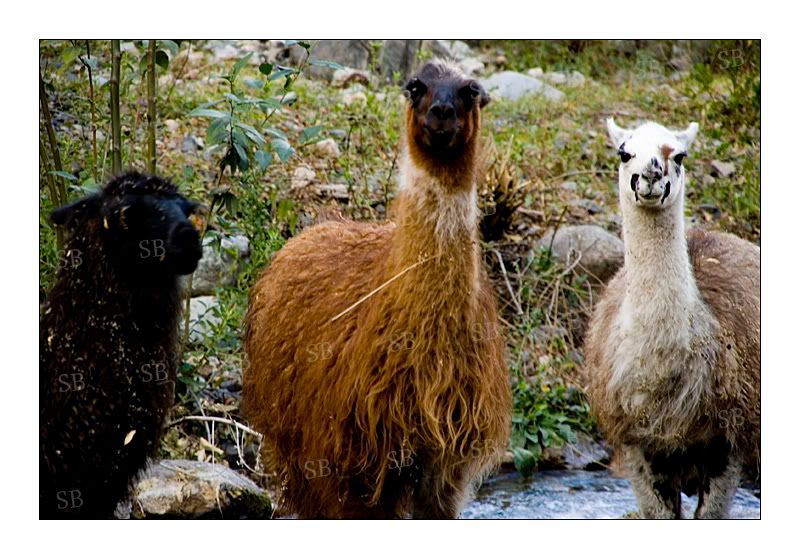
i lived in Choco for a month in 2006 without seeing a single llama… but the llama owners came down from many miles upstream to enjoy the festivities and could hardly leave their llamas alone.
So fear not… i did get a llama picture up.
This update is so long… i’m going to break down what i was going to do for my Choco half of the update into two sections. i have an essay devoted to preparations for the fiesta, and i am going to break it down into an essay focused on some of the work that was done, which will be included in this update, and an essay focused on some portraiture of some of the people of Choco as the preparations were being made, which will be included in the next update. Sorry, Julie… no Juana or Ruly in this or the next update… eventually there will be a bit of Juana, though, and i’ll email you a Ruly picture or two when i make it back to the states.
This man’s name is Jesus. No, not that Jesus… but he is a very nice man.
He was in Choco in 2006 when i came, and is one of the soccer players. He might be my favorite Choco native.
For you see… he just seems to be a happy man. In 2006 he became nicknamed “The Pirate” within about 2.3 minutes of our team meeting him. But he is a very happy pirate.
i have never found a bigger smile in all of Peru. And not only is it a big smile, but they are big, white teeth. Except for right in front. That is big, black not-tooth. If i was casting a movie about Peruvian pirates, he would be the first person i called, and he would smile a lot—because that is what he does—and show off that missing tooth and those great pearly whites.
He’s not smiling in this picture though… that’s because he’s working on digging a post hole out of the middle of the street in Choco’s main plaza. This post hole would hold—oh the shock!—a post that would support the… altar/shrine/trifold presentation?/platform for the celebration of Choco that was under construction.
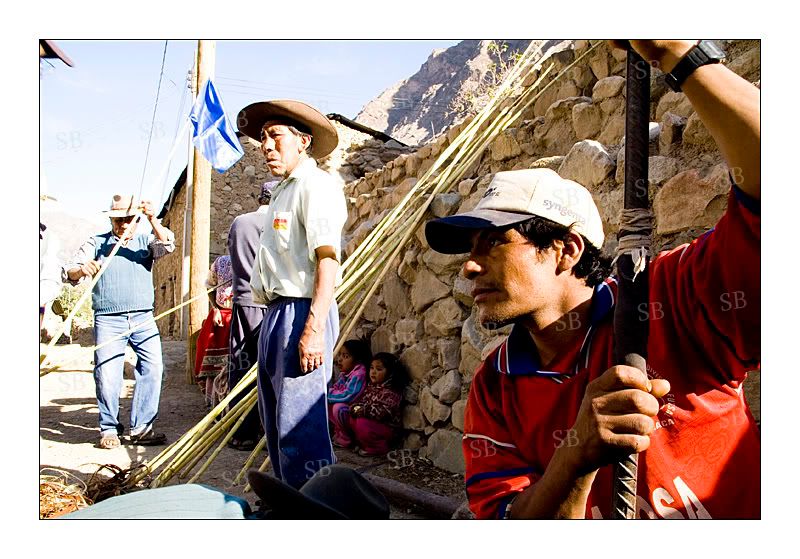
i don’t know this man’s name. If i had a wider angle lens (maybe even Philip’s 16-35 would have done the trick… i think it would have done lots of tricks on this trip though :-D) i would have been able to include more of what he is actually doing… but i still like the picture. This man is tying the Peruvian flag to a pole that will be attached to the altar/shrine/trifold presentation?. And looking at me like i am very very strange.
i think he’s probably right.
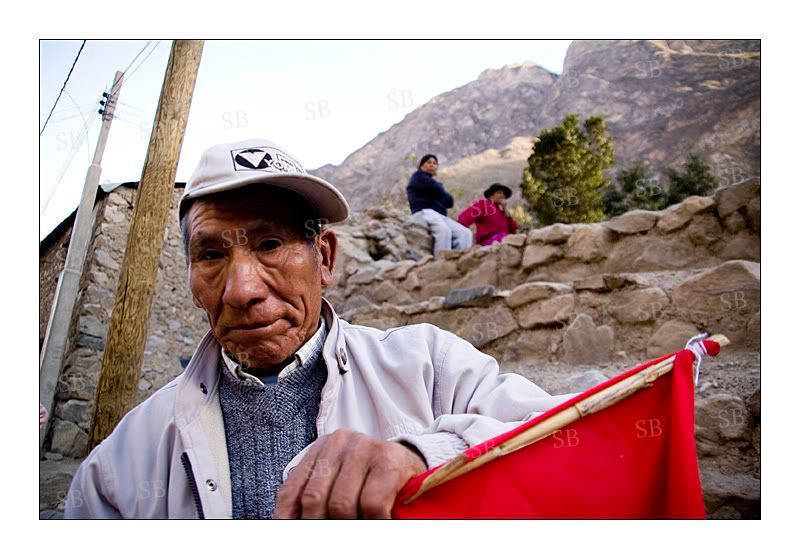
Choco called in a traditional band from Cabanaconde. They played two songs, and they played them a lot. They sang a lot better when they were sober… but i didn’t experience that very often, so i can’t be positive.
“Dime amorcita, cual es tu problema? Me haces mucho daño!”
“Tell me, my little love, what is your problem? You do me a lot of damage!”
This line was sung many, many times. And sometimes very, very inebriatedly. i am sorry for making up words like “inebriatedly”.
So here they are likely talking about which of their two songs to play while in the background locals get ready to do some hardcore dancing. No, not that kind of hardcore dancing… these people basically hold hands and walk in a circle. It’s very exciting.
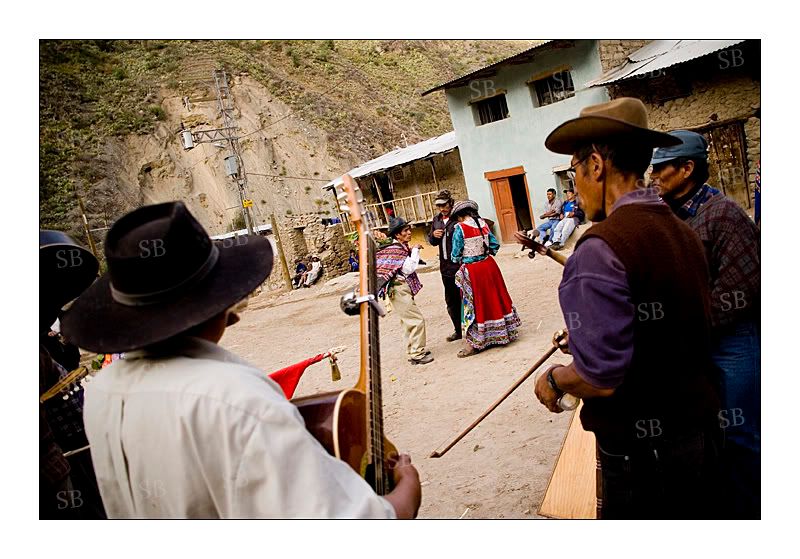
Finally… as things began to get a little bit closer to completion, the bread bouquets came out. Bread bouquets? Oh yes… they’re a big deal in Choco. Get a nice bouquet of flowers together (i think it’s classy that Choco-ites have the sense to grow some flowers with their more practical vegetation. Definitely a positive in my book), stick some skewers in, and add a few pieces of bread.
Here, some locals reclaim some of the bread from a bouquet that was apparently over-breaded.
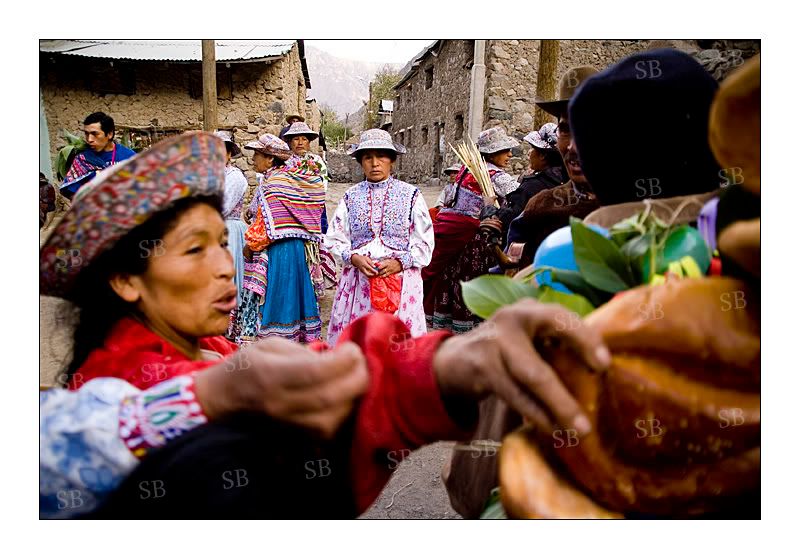
And welcome to Choco, my friends… i will be in Choco for probably at least five or six more updates… and i won’t even include most of my best pictures, i’m sure.
Coffee, i’m telling you…
And here is to successful boycotts…
2 comments:
All I can say is that a President who has a name like Alan (and spells it correctly)...can't be all bad.
I agree with you on the disservice of telling someone he is poor. Poverty seems to be a relative thing. Part of true poverty seems to be involved with envy and coveting.
Post a Comment